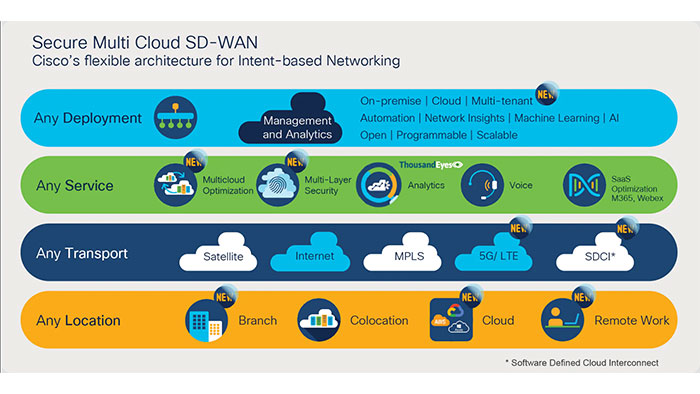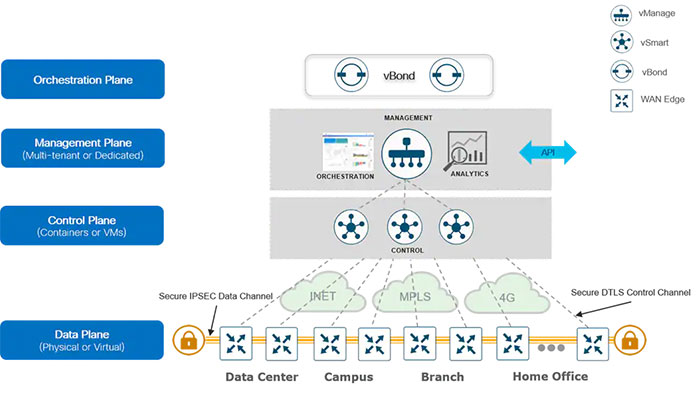SD-WAN Technology
Within the SD-WAN, which is the story of applying software defined networking concepts to the wide area networking, the control plane manages the rules for the routing traffic through the overlay network, and the data plane passes the actual data packets among the network devices. For this solution the following roles should be provided.
- Orchestrator: a mechanism which can orchestrate connectivity.
- Management: an appliance that provides the management capabilities for this environment.
- Control: A mechanism which deploy all different topologies and policy enforcement.
- Data: Responsible for carrying application data in the environment.
To deliver these capabilities the solution has four appliance types that will provide mentioned specific roles
Cisco vBond which is responsible for orchestration and initiates the bring up process of every vEdge device, at the first step it creates secure tunnel with vEdge and informs vSmart and vManage about its parameters like for instance IP address. It has to be fully connected with every device.
Cisco vManage that is a fully manageable centralized portal to run and operate software defined network (SD-WAN).
Cisco vSmart which is a controller for your network, it is responsible for managing all control and data policies by using special Overlay Management Protocol (OMP).
Cisco vEdge is a router which receive complete control and data policies from the vSmart, it is able to run routing protocol like OSPF, BGP to create connectivity on LAN side but also with MPLS provider if necessary. It establishes secure IPSec tunnels with others vEdges depending on selected topology.
These four appliance types will make up the Cisco SD-WAN solution. vBond, vManage and vSmart, are the virtual entities which can reside on premise or in the cloud. The most common consumption of this is as a service directly from Cisco. vEdge is an actual router that will leverage in this solution and could be in various form factors such as: ASR1000 or ISR4000, Virtualized Routers like CSR1000v and Catalyst 8000 Edge Platforms.
Cisco SD-WAN Terminology
You can find the SDWAN terminology meaning of the terminology used to describe a Cisco SD-WAN overlay network in the following:
- Domain ID: A unique integer which is a logical grouping of edge routers and Cisco vSmart Controllers. You can configure only one domain in a Cisco SD-WAN overlay network.
- TLOC: A transport location which identifies the physical interface where an edge router connects to the WAN transport network or to a NAT gateway.
- OMP Routes: Overlay Management Protocol (OMP) advertises to its peers the routes and services that it has learned from its local site, along with their corresponding transport location mappings, which are called Transport Locations (TLOCs). These routes are called OMP routes. Cisco SD-WAN control plane uses three types of OMP routes:
- OMP routes: Prefixes that establish reachability between end points.
- TLOCs: Identifiers that tie an OMP route to a physical location.
- Service routes: Identifiers that tie an OMP route to a service in the network.
- Site ID: A site is a particular physical location within the Cisco SD-WAN overlay network.
- System IP Address: This address is similar to the router ID on a regular router.



